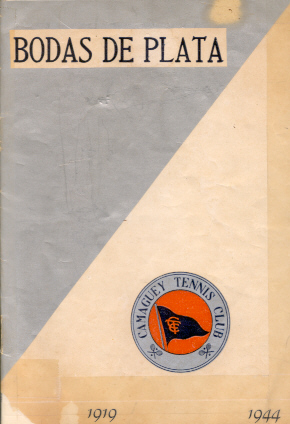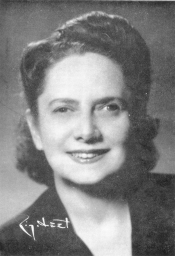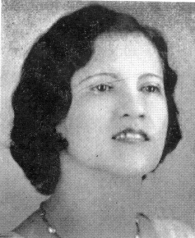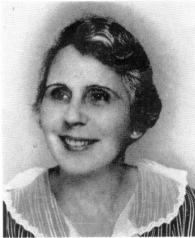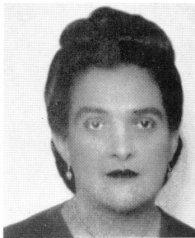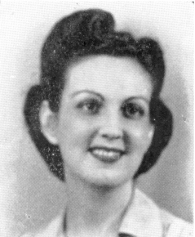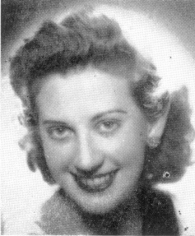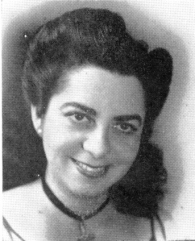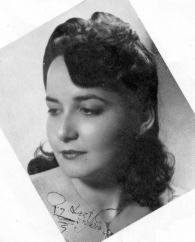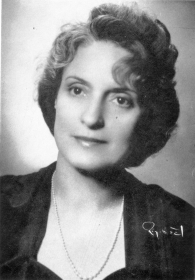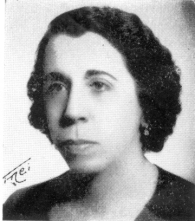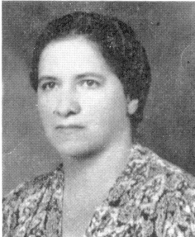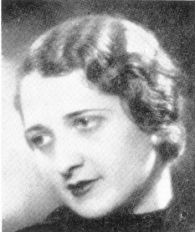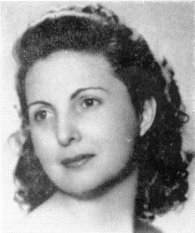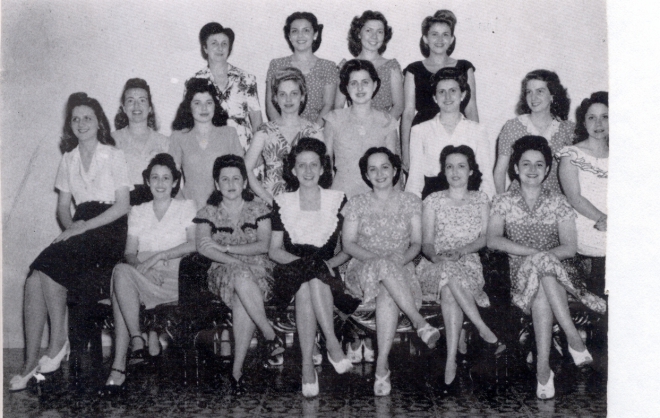| |||||
|
SOUVENIR DE LAS "BODAS DE PLATA" DEL "CAMAGUEY TENNIS CLUB" CON BOSQUEJO HISTORICO POR EL DR. FELIPE PICHARDO MOYA • 1919 :-: 1944 |
SOUVENIR OF THE "SILVER ANNIVERSARY" OF THE "CAMAGUEY TENNIS CLUB" WITH A HISTORICAL SKETCH BY DR. FELIPE PICHARDO MOYA • 1919 :-: 1944 | |||||||||||||||||||||||||||||||||||
| Primera Página |
Title Page | |||||||||||||||||||||||||||||||||||
|
Se debe notar que el Camagüey Tennis Club fue uniquo entre clubes sociales de deporte en Cuba y quizás en todo el mundo. Este Club fue fundado, manejado, y propiedad de mujeres. Sólo mujeres podrían ser socios; hombres, incluyendo esposos, solamente podrían asistir como invitados de una socia. | It should be noted that the Camaguey Tennis Club was considered unique among social sports clubs in Cuba, and perhaps in all the world. The Club was founded, owned and operated by women. Only women could be members—men, including husbands, could use the facilities only as guests of a member. | |||||||||||||||||||||||||||||||||||
|
| |||||||||||||||||||||||||||||||||||
|
| |||||||||||||||||||||||||||||||||||
|
| |||||||||||||||||||||||||||||||||||
|
| |||||||||||||||||||||||||||||||||||
|
| |||||||||||||||||||||||||||||||||||
|
CONFERENCIA HISTORIA DEL "CAMAGUEY TENNIS CLUB" POR EL DR. FELIPE PICHARDO MOYA • 1944 |
CONFERENCE HISTORY OF THE "CAMAGUEY TENNIS CLUB" BY DR. FELIPE PICHARDO MOYA • 1944 | |||||||||||||||||||||||||||||||||||
| Triste privilegio, señoras y señores, el de poder recordar cosas ocurridas hace veinte y cinco años—¡hace un cuarto de siglo!—pues ello significa, dado que habitualmente no se tiene memoria de lo sucedido antes de los cinco años, que ya tenemos treinta de edad. Triste privilegio, al que debo el honor de estar aquí esta noche, con mi mujer, en nuestro carácter de padrinos del bautismo de esta casa, cuando no era más que un salón recién levantado entre viejas ruinas, para contaros cómo fueron los comienzos de esta institución, honra de Camagüey; de este Camagüey Tennis Club, sociedad no superada, ni en lo espiritual ni en lo material, por ninguna cubana de su género; obra maravillosa de la inteligencia y la constancia y la capacidad creadora de la mujer camagüeyana. Naturalmente, no podré contar muchas cosas de las ocurridas en aquellos días iniciales, por falta de memoria y por falta de tiempo. Pero seguramente algunas y algunos de mis oyentes, compañeras y compañeros de primeras letras de aquellos tiempos felices, las recordarán, y podrán contarlas reparando mi deficiencia, en agradables conversaciones que no tendrán la obligada formalidad de esta charla que pudiéramos decir pública, y en las que pueden tener cabida anécdotas que aquí la discreción me veda referir. Corría el año de 1917, y terminada mi carrera, vine a ejércerla a ésta mi ciudad natal, de la que me había ausentado de seis años de edad. Vine a trabajar al bufete de mi hermano mayor; jugar al tennis era uno de mis trabajos predilectos. Pero en realidad, no había en Camagüey, un tennis que valiera la pena. Un parvulito de entonces, Nicolás Don Zaldívar—ya en aquellos momentos, su hermano Tirito estaba bastante usado—me llevó a un court que había en la Zambrana, en casa del que era como un hermano de mi hermano, José Morel Padilla; y allí jugué tennis por vez primera. Quiero rendir aquí un cálido homenaje al recuerdo de mi compañera en el bello deporte, una joven de alma noble y clara inteligencia, que la Muerte arrebató al cariño de esta sociedad en pleno florecimiento de gracias femeniles, a Sarita Fernández; y envío un saludo cordial a otra tennista del grupo, a Lolán de Varona, mientras recuerdo la adolescencia maravillosa de Carmitina Agüero, flor de mármol de impecable belleza. El tennis de la Zambrana fué un relámpago. Pero en el Parque Gonzalo de Quesada había un court de cemento, agrietado e incómodo, no lejos del lugar donde ahora alza su símbolo inmortal el Soldado Desconocido, frente a donde hoy se extiende la mirada de mármol del inmenso Salvador Cisneros Betancourt. Allí, —y otras veces también en una quinta que tenía, cercana a la Caridad, Gabriel Cadenas—, nos reuníamos los devotos del tennis. Allí, en los viejos bancos de piedra, supervivientes de coloniales tiempos, Josefina y Clara Álvarez González, y su sobrina Luisa; Margarita Recio; Angela Isabel Caballero de Cadenas, que vé hoy a sus hijas heredar su belleza, sin perderla ella; Isabelita Garcerán; Fé de Varona, blanca y serena como la luz de la luna, eran asiduas concurrentes; y por allí pasó también, con la majestad ardiente de su belleza criolla, Gloria Simoni, y pasó la gracia gitana de Aurelia Garcés, mientras a veces quería escaparse del cuidado de su manejadora, para incorporarse al grupo de las mayores, una niña de oro y marfil, poco después adolescente de espléndida belleza, y hoy señora de grácil distinción, Charo Alvarez de Tomeu. [ El Casino Campestre es uno de los parques urbanos mas grande de la isla. Fue donado a la ciudad en el siglo anterior por el marqués de Santa Lucia, Salvador Cisneros Betancourt. Tiene una gruta, estrados para orquestras, céspedes, jardines, paseos, estatuas y monumentos, bancos sombreados, áreas para almuerzos al fresco, y, como nos hemos enterado, en 1917 también tenía una vieja cancha de tenis de cemento.—Ed.] Otras muchas jóvenes desfilaron por aquel pequeño campo de tennis del Casino. Y allí, en las tardes, la belleza de nuestras mujeres recibía el homenaje de oro del sol poniente. En cambio, éramos pocos los feos que allí concurríamos. Entre tanta belleza femenina, una figura se destacaba, en belleza física y espiritual. Alta, blanca y nimbada de oro pálido, había sido tallada en mármol por un escultor impecable, y la noble sangre de una estirpe legendaria le prestaba una serena arrogancia, que de cerca se convertía en amable sencillez. Las propias jóvenes admiraban su gracia inimitable, y los hombres, atraídos magnéticamente por su humana belleza, aún más se deslumbraban por su trato exquisito. Tenía cálida la voz, rica de emoción, y su risa era ciertamente de resonancias musicales. Y con esa voz, que a todo prestaba el encanto de una confidencia, Pilar Garcés expuso una tarde la idea de fundar una sociedad en terrenos del Casino Campestre; una sociedad fundada y dirigida por muchachas, donde se atendiera al deporte, y al recreo de la juventud camagüeyana, necesitada de expansiones espirituales. La idea fué acogida con general beneplácito. La inteligente actividad de Célida Recio se sintió en el acto despierta, y devota de aquel proyecto. Isabelita Garcerán, con el entusiasmo que siempre pone en todas sus cosas, no quedó en segundo lugar. Cuca Batista, que nunca faltaba en las tardes al Casino, donde siempre decía la palabra oportuna en el momento preciso, sin que jamás discutiera su turno a la hora de tomar la raqueta, en altanera indiferencia, fué también de las primeras en secundar la idea de Pilar Garcés. Reclamo para Ventura Martínez y para mí, el honor de ser, en aquellos momentos, los únicos del sexo feo que nos dispusimos a ayudar a las muchachas en su al parecer fabuloso proyecto. Pero todo eran voces y propósitos. Un ejército entusiasta de muchachas, se disponía a librar una batalla por la fundación del Camagüey Tennis Club—tuvo su nombre muy tempranamente—y reunido al conjuro de Pilar Garcés, esperaba la voz de mando del técnico militar que las llevara al asalto y al triunfo. El técnico, —el General—, fué elegido, y lo fué también su Estado Mayor, el día 30 de enero de 1919; y desde entonces hasta ahora, cuando las
Fué elegida Presidenta del Tennis—que existía solo en propósitos—Zoila Sánchez Mestril. La Vice fué Pilar Garcés: Cuca Batista e Isabelita Garcerán fueron Secretaria y Vice. Célida Recio, la Tesorera, y Sara Sánchez Estrada su Vice. Las Vocales fueron Margarita Recio, María Luisa Calaforra, Aurelia Garcés, Eugenia Recio, Pilar Iraola, María Alvarez, Esperanza Sánchez, Lolita Garcés, Mercedes Calaforra, Ana María Estrada, Rosita Agramonte y María Luisa Tomeu. Hoy, en este día de conmemoración para el Camagüey Tennis Club, Mercedes Calaforra, lejos del mundo que abandonó llamada por la voz de su fé en Dios, no pensará que aquí sus antiguas compañeras celebran este aniversario. Pero nosotros la recordamos, como recordamos con especial afecto a otra fundadora, entusiasta como pocas, hoy también esposa del Señor, consagrada por su amor a consolar el dolor humano, en retiro de íntima luminosidad, a Sor Leocadia, en el mundo Esther Sariol, que sabe Dios junto a qué anciano desvalido hace en estos momentos el papel de amorosa hija, a impulsos de su fé cristiana. Porque yo fuí testigo, como lo fué Ventura Martínez, de la difícil obra de fundación de este Camagüey Tennis Club, tengo el deber de decir que la noble idea de Pilar Garcés, encontró en Zoila Sánchez Mestril el fuego creador que la hizo cristalizar. El carácter, la inteligencia, el acto, la constancia de Zoila Sánchez; su consagración constante al Tennis; su firmeza en el propósito y su habilidad para sortear innúmeras dificultades, hicieron posible esta obra; sin que sean menores sus méritos ni su labor deba ser menos admirada por el hecho de que la auxiliaran, con igual devoción e inteligente eficacia, otras muchachas—algunas que ya hemos citado, como Isabel Garcerán y Célida Recio, y otras que no es posible que citemos, porque haríamos una larga relación de nombres. Acordado pedir al Alcalde en arrendamiento el terreno en que hoy se levanta esta sociedad, se hicieron las gestiones pertinentes. Este arrendamiento—por un plazo de 10 años y por 25 pesos mensuales—no fué obtenido sin dificultades, pues era precisa la conformidad del Ayuntamiento, y no pocos concejales no lo veían con buenos ojos. Anecdótico es recordar, en relación con esto, dos casos en que se logró atraer a dos de los principales opositores. En uno, actuaron directamente las muchachas, con Pilar Garcés al frente. Se trataba de un viejo y popular concejal, destacado político, que unía a su condición de regidor otra de más sagrado respeto. Hombre bondadoso y recto, fácilmente accesible para toda caridad, era al mismo tiempo de franca rudeza, que le autorizaban sus especiales virtudes. Liberal y demócrata sincero, no veía con buenos ojos la idea de que se diese a una sociedad exclusiva, tildada de aristócrata, una propiedad que pertenecía al pueblo, y que éste debía disfrutar sin discriminación de clases. Una tarde, un grupo de muchachas del Tennis, —del futuro Tennis—, con Pilar Garcés al frente, fueron a visitar al batallador concejal, en su amplia y modesta casona de la calle del Cristo. En el enorme patio, aquel terrible enemigo del arrendamiento solicitado, daba de comer a sus aves de corral, y no se había dado cuenta de que en la sala de la casa estaban aquellas muchachas, que no se atrevían a interrumpirlo. Ellas esperaron pacientemente; una tos iba y otra venía; una risa y un comentario se ahogaban alternativamente en el silencio hostil. Pero como todo tiene fin en el mundo, al fin el popular Párroco de la Iglesia del Cristo terminó su labor, y vió a las visitantes. Naturalmente, las conocía a todas; conocía a sus familias; sabía de sus nobles propósitos; pero el Casino Campestre pertenecía al pueblo de Camagüey, y al pueblo se le iba a privar del disfrute de una parte del mismo, para recreo de unos cuantos privilegiados. No era posible votar a favor de aquel arrendamiento; y bien podían las muchachas buscar otro terreno, en otro lugar de la ciudad. Alrededor de estos tópicos, la visita fué larga. Pero Pilar Garcés triunfó una vez más, y el celoso concejal, hombre que a su bondad natural unía extraña firmeza de carácter, quedó convencido, y no combatiría el arrendamiento, ni impediría que sus amigos lo votasen. En el otro caso me tocó intervenir directamente, por unirme al opositor una antigua amistad, que me permitía invocar el nombre de mis hermanos mayores, que habían sido sus compañeros de infancia. Iguales razones, más robustecidas por alegaciones a la convivencia racial de todos los cubanos, eran aducidas en contra del arrendamiento por un concejal, inteligente y activo, que podía arrastrar otros votos en la Cámara Municipal. Logramos atraerlo a nuestro favor; y hasta su muerte, hace pocos meses, al encontrarlo en la Habana, donde vivía, anciano y ciego, aún me preguntaba por el Tennis y sus muchachitas. Fué obtenido el arrendamiento, siendo necesaria una labor de convencimiento de muchos concejales, como hemos visto por los casos citados. Diremos, de paso, que su prórroga años después, cuando ya el Tennis existía en realidad, no dió tantas luchas, contando además con el apoyo directo y eficaz del Alcalde Domingo de Para, que siempre fué un amigo del Camagüey Tennis Club. Ya las muchachas tenían terreno sobrado, con los viejos paredones de una derruida casa, entre maniguales hirsutos. Existían, en las mentes, dos courts de tennis, un campo de basket ball, y una hermosa casa social. En las cajas de la sociedad, no existía nada, —ni siquiera una libreta para calcular los gastos futuros. Comenzó entonces aquella época inolvidable para las fundadoras, cuando eran llamadas "Alí Babá y los Cuarenta Ladrones", porque todo inteligente recurso legítimo para captar fondos fué puesto en práctica. Un baile en el Liceo, en 23 de mayo de 1919, una verbena en el Casino Campestre, una velada en el antiguo teatro Principal, una emisión de bonos por 50 y 25 pesos, permitieron a las muchachas reunir lo necesario para cercar y limpiar el terreno y comenzar la reedificación de la vieja casa existente en este lugar. El ingeniero y arquitecto Bernardo Junco ofreció gratuitamente sus servicios profesionales, y a él se deben las primeras obras aquí realizadas. En febrero de 1920 se eligió una nueva Directiva. Zoila Sánchez fué reelecta Presidenta; y la ausencia de Pilar Garcés incorporó al estado mayor tennista, como Vice-Presidenta, a María Magdalena Martínez, inteligente y bella y entusiasta. María Magdalena Martínez, que la muerte arrebató cruelmente cuando iniciaba su vida de amante esposa junto al elegido de su corazón; María Magdalena Martínez, de una estirpe en que la virtud y la inteligencia son comunes en hombres y mujeres. Isabelita Garcerán y Célida Recio continuaron en el estado mayor, y entre las nuevas, Ana Margarita Delgado fué Vocal digna de especial mención por su activa labor, y Rita Allie Betancourt, prodigio de gracia y de belleza, era electa Vice-Secretaria, y Fina Mola Benavides, Vice-Tesorera. Aquí es necesario hablar un poco de los hombres que de modo especial cooperaran a la obra del Tennis. Ya hablamos de Bernardo Junco, director facultativo de las construcciones, y citamos pasajeramente a Ventura Martínez. Pero es preciso hablar más de Ventura. Era, en una pieza, administrador, capataz, obrero, tennista, apuntador en las veladas. . . y hasta veterinario, pues cuidaba del caballo del Tennis. ¡El caballo del Tennis! Ingratos seríamos si no le dedicáramos un recuerdo. Yo no sé de donde lo trajeran; no sé de qué hospital había salido aquella armazón de huesos, que se utilizaba para arrastrar el primitivo rodillo que servía para apisonar el court, que los propios tennistas marcábamos luego con las rayas rituales. Pero lo trágico del caballo, no era su pobre figura, sino su terrible dolencia: Porque tenía una antigua herida sin cerrar, en el cuello, por donde se salía el agua que tomaba. Y de aquí que Ventura velara por él, con amor de hermano, aquí, en estos terrenos donde más tarde, al llegar del colegio donde había terminado sus estudios, una bella adolescente llamada Elia Rodríguez Casas, Ventura se sintió sin ventura, herido en pleno corazón, hasta que pudo hacerla su noble esposa. La labor de Ventura Martínez, prodigaba a todo cuanto significara beneficio para el Camagüey Tennis Club, es inolvidable en esta casa. Y además, era un jugador sereno y fuerte del bello deporte, compañero inseparable, en éste, de Salomé Zayas Bazán, y formando ambos una pareja que hubiera sido siempre vencedora, de no existir la que formábamos Aurelia Garcés, —elegante en el tennis como pocas— y yo. Conste así. Y hablando de Ventura, y del caballo surtidor, y antes de abandonar los primitivos courts y sus cosas iniciales, recordemos también al primer conserje, o mayordomo, o como quiera llamársele, que en realidad yo no sé qué era, ni recuerdo su nombre, que tuvimos aquí. Era un hombre de campo, —según creo, adquisición de Isabelita Garcerán—, bajito y vestido con camisa y pantalón azul, que usaba siempre un enorme cuchillo a la cintura, cuando no ceñía machete, y que en realidad estaba medio loco. Por lo que, siendo guardián del Tennis y encargado de limpiar los campos y la casa, y de otras cosas por el estilo, nadie se atrevía a darle una orden, temiendo sus reacciones, que eran extrañas y hasta violentas. Una fantástica anécdota, rigurosamente histórica, se impone aquí, en relación con este primer conserje del Tennis. Esta sociedad daba su primer baile de gala, y Ventura Martínez recomendaba valientemente al buen conserje que, para esa noche, debería afeitarse y vestirse de limpio, y abandonar el machete. Pero el pintoresco guardián dijo—y esto dá una idea de su procedencia montuna—que esa noche él por nada del mundo estaría presente en el baile; pues, cuando empezara el cedaseo, se formaba en seguida el macheteo, y él no quería sufrir un machetazo. Y no se le pudo convencer de lo contrario, y no asistió al baile este primer maestro de ceremonias del Tennis. El caballo y el primer conserje, merecen esta noche un especial recuerdo. Manolo Bonanza, Jorge Bertrán, Alfredito Mola y el múltiple Carlín Galán, eran los habituales galanes de nuestras veladas increíbles. Hasta Alvaro Armiñán lo fué también, por dos veces, y una de ellas nada menos que vestido de Arlequín, si bien con el agradable papel de decir versos de amor a Rita Allie Betancourt, que encarnaba a la Marquesa Rosalinda, —la maravillosa Rosalinda de don Ramón de Valle-Inclán. Nuestras veladas eran cosas muy serias, y muy importantes, porque eran fuente inagotable de magníficos beneficios económicos, bajo la sabia administración de Alí Babá y sus 40 Ladrones. Ventura Martínez era siempre el apuntador, y yo era director escénico, y autor de las obras, cuando no adaptador irreverente de las de conocidos autores. Porque lo original era que, por una parte, no había entonces entre la gente joven, —con muy pocas excepciones—, aficionados a la escena; y por otra parte, aunque los hubiera nada importaba, porque Alí Babá y sus 40 Ladrones exigían que los papeles se repartieran, no entre quienes tuvieran condiciones para desempeñarlos, sino entre quienes garantizaran por sus simpatías sociales y amplias relaciones familiares, una buena venta de localidades. Así escogidos nuestros actores con tan interesada mira, comprometidos a la fuerza a trabajar por el Tennis, había que hacer para ellos papeles especiales, o adaptar a su gusto los de obras hechas. Ninguna muchacha quería hacer un papel que no fuera de dama joven. Nadie quería hacer un papel antipático. Cuando una frase no gustaba—el caso se dió varias veces cuando representamos "El Patio", de los hermanos Quintero—había que modificarla al capricho del actor, o éste no trabajaba. Nadie estudiaba sus papeles, ni hacía caso del director de escena ni del apuntador. Es un hecho cierto que Ventura Martínez, durante los ensayos y en su papel de apuntador, tomaba un bastón de los míos—los ensayos eran siempre en mi casa, donde por estar en alto, el bullicio era más tolerable del vecindario—y le pegaba en el pié al actor para avisarle que tenía que entrar a hablar. El día de la función, estábamos casi como el primer día; y no era nada extraordinario que esa misma mañana algún actor o actriz se volviera atrás, y entonces se buscaba un héroe o heroína que hiciera de sustituto. En estas condiciones, debutó una vez Manana Adán Molina, en no recuerdo qué obra, confiada al auxilio que en escena le dieran sus compañeros. Salió a escena de un disimulado impulso—por no decir empujón—que le dí, y su cara de susto, casi llorosa, venía bien con su papel. Fué un éxito ruidoso. Por último—y esto era terrible para el director de escena—ya entre bastidores y todo preparado para la función, era costumbre quitarse el miedo con los correspondientes tragos; y entre éstos y el poco estudio de la obra, cada actor improvisaba en escena lo que le daba la gana; y más de una vez me recuerdo abrazado a algún galán joven, sujetándolo, para evitar que saliera a escena antes de tiempo, tal como le sugerían los tragos animadores. Comedia hubo en la que los mejores chistes se improvisaron en escena por los noveles actores; y en este aspecto, justo es recordar especialmente a Manolo
Hagamos constar que más tarde, el Tennis pudo dar algunas veladas con un buen cuadro escénico. Fernando Martínez Lamo—entusiasta y magnífico aficionado—Antonio Valdivia y Antonio Martínez, brillaron en la escena, menos apremiada por Alí Babá. Ana Coralia Porro prestó su hermosa voz; Laura Arango su devoción por las tablas. Mongo Tomé hizo de tenor. Para terminar con las veladas, recordaremos una que dimos en Camagüey y se repitió en Ciego de Avila, ya con este último cuadro de actores, y cuando una crisis en las fabricaciones del Tennis hizo que Salomé de Zayas Bazán, Presidenta sucesora de Zoila Sánchez, reviviera los tiempos de Álí Babá, con envidiable energía. Se trataba de una opereta, nada menos, con música de Félix Rafols, y libreto mío: "La Princesa Guamaná". Era preciso llevar a Ciego de Avila, con toda la compañía y su decorado, una orquesta de doce profesores. Recuerdo perfectamente que el traslado y la estancia en Ciego, ascendían a quinientos y pico de pesos. Se iba a representar un sábado de gloria; y los músicos tuvieron que ensayar en Semana Santa, a escondidas. La venta de localidades en Ciego se había confiado a amigos de aquella población. En un gas-car expresamente fletado, llegamos a Ciego a las cuatro y media de la tarde, el día mismo de la función. Y encontramos que no se había vendido una sola localidad, por distintas causas, y entre ellas una confusión sobre la fecha del evento, y la ausencia involuntaria, en los días anteriores, del amigo que hacía de agente nuestro, el inolvidable y caballeroso Rafael Flores del Monte. Era un verdadero desastre. Repetimos que el Tennis se había empeñado en más de quinientos pesos. Pero Alí Babá, —entonces Salomé Zayas Bazán, digna sucesora de Zoila Sánchez—, dispuso en el acto que en vez de hacerse un proyectado ensayo general, —que Rafols reclamaba a voz en cuello para la parte musical de la obra—, los actores y las actrices se repartieran por todo Ciego vendiendo localidades, en tanto nuestra orquesta tocaba ruidosas piezas en el Parque Central, y Antonio Valdivia inflaba frente al Teatro, y elevaba, un globo de caprichosos colores, que había sacado yo no sé de dónde, y se disparaban numerosos voladores. Ciego de Avila respondió al reclamo. Los quinientos pesos gastados fueron repuestos, y más de seiscientos quedaron libres, de ganancia para el Tennis. Recordemos, de paso, que en esta velada ofreció un bello número de baile clásico una bella americanita, Miss Grubber, hija del que era entonces Administrador General de los Consolidados. Y recordemos también, para no hablar más de veladas, a los famosos coritos. Esto es, coros infantiles, donde las más bellas niñas camagüeyanas eran como vice tiples de nuestra compañía. Alicia Sánchez, Lila Arteaga, Flérida Ruiz de Castro, Elsa Longoria, Nenita Cabezas, las hermanitas Morán y otras más, contribuyeron a las obras del Tennis con el mismo entusiasmo que las muchachas mayores. Estas, por su parte, también formaron distintos coros, siendo el de las hawayenses uno de los más comentados, pues atrevidamente, las muchachas llevaron la falda . . . un poco más abajo de la rodilla. Todo esto ocurría allá por 1922 y 1923. Zoila Sánchez había sido Presidenta hasta abril de este último año. Como ya dijimos, fué su sucesora Salomé de Zayas Bazán, todavía cuando el Tennis padecía las naturales dolencias de su desarrollo. Una de ellas había sido la de formalizar con el contratista un detallado contrato para la construcción del salón de baile y los pocos anexos de que entonces constaba la casa social. Como no había fondos en caja—se los reunía poco a poco, por verbenas y veladas—era necesario que un fiador solvente garantizara el cumplimiento del pago por parte del Tennis. Naturalmente, nadie que fuera solvente quería ser fiador. Cuando Isabelita Garcerán casi convencía a su padre—el inolvidable don Augusto Garcerán de Vall—para que lo fuera, ocurrió lo inesperado: El contratista, sin duda hombre muy optimista, me aceptaba a mí como fiador. Tuve el alto honor de serlo, yo, uno de los cuarenta compañeros de Alí Babá; y la casa se inauguró el primero de enero de 1923. Monseñor Pérez Serantes, Ilmo. Obispo de Camagüey, la bendijo, y mi mujer y yo fuimos los padrinos. Por la noche, se dió un regio baile. Salomé dió al Tennis su constante e inteligente devoción. No es posible cansaros con los sucedidos de su Presidencia—el de la velada en Ciego fué uno de ellos—que fué agitada y difícil como la de su antecesora, y en la que Salomé demostró sus admirables dotes de organizadora, su exquisito don de gentes, su habilidoso tacto. Al recordar aquí su labor, admirable, yo no puedo dejar de recordar también, con un sincero afecto, como a cosa propia, a aquel que, tan cercano a ella, fué nuestro amigo respetado y querido; al caballero intachable de una vieja y noble estirpe camagüeyana, de virtudes múltiples, en cuyo hogar acogedor tantas veces nos reunimos para hablar de este Tennis; a don Javier de Zayas Bazán. El Camagüey Tennis Club, ya puesto en marcha de victoria, continuó de triunfo en triunfo. Realmente, la sociedad camagüeyana se sintió orgullosa de esa obra. Y bueno es recordar que hubo tropiezos desagradables, y catástrofes más o menos risibles, que sirvieron para probar la adhesión y cooperación de los amigos del Tennis. En este sentido, quiero hablar de la más grande y bien organizada verbena que se ha hecho en nuestra ciudad, de fantásticas proporciones, que fué en su comienzo destruida por un inmenso aguacero de verano. El magnífico esfuerzo de Alí Babá, cayó esta vez en el vacío. María Luisa Betancourt no me dejará mentir. Se había escogido para celebrar la verbena el día de San Juan, y se había logrado, tras titánica lucha, que se nos permitiera celebrarla en el Casino Campestre, cerrado a todos los que no pagasen la entrada, inclusive las máquinas que, en el tradicional paseo de San Juan, deberían pasar por allí. Las máquinas pagarían cincuenta centavos. Los numerosos kioscos, bien abastecidos de diversiones, refrescos y bebidas, y uno de ellos convertido en restaurant, se engalanaron desde temprano. Allí estaba toda la plana mayor del Tennis. Poco después de las cinco de la tarde, apenas abierta la verbena, ya la recaudación ascendía a trescientos pesos. Los resultados iban a ser fantásticos. Vino entonces la lluvia. Terrible, continuada, insoportable. Se acabó el paseo de San Juan. Se inundaba todo. Las colgaduras de los kioscos se deshacían, tiñendo a las muchachas de raros colores. Objetos de regalo y comestibles se perdían. Los concurrentes andábamos calados hasta los huesos. La desbandada era incontenible. Pero había que salvar los intereses del Tennis. Allí estaba Alí Babá—Zoila Sánchez—y allí estaba, entre otras entusiastas, María Luisa Betancourt, con su esposo Luis Loret de Mola. El Tennis tenía entonces fabricado apenas su salón de baile, sin muebles. Se decidió llevar al salón cuanto pudiera salvarse de la lluvia. En pleno aguacero, así se hizo. Y ocurrió entonces lo trágico... lo trágico, que pudo ser aterrador, pero que, recayendo sobre un caballo, nos permitió a todos precavernos. Por la humedad del suelo, se electrizaron las columnas de entrada del Tennis, y al cruzar esta entrada, en el piso, el alambre eléctrico que conducía la luz de las farolas, electrizó parte del propio piso. Seguramente, algún defecto de la instalación. Un caballo, de un carro que pudo conseguirse para trasladar algunos efectos, cayó muerto. Fué preciso entrar en los terrenos del Tennis con mil precauciones; y allá en el desnudo salón, donde nada había, ni sillas ni cuadros, las muchachas, llovidas, despeinadas, manchados sus trajes con los tintes de las telas y papeles que adornaban los inundados kioscos, esperaban, tristemente sentadas en el suelo, que la lluvia terminara. Pero el Tennis era invencible: María Luisa Betancourt discurrió llevarse las bebidas, y algunos obsequios de fácil conducción, a la Sociedad Popular, donde se celebraba un baile, y vender allí cuanto se pudiera. Allá fué Luis Loret de Mola: Se obtuvo el consentimiento de la Directiva de la Popular, y allí llevamos el kiosco de las bebidas y los helados, y algo pudo salvarse del desastre. Así se trabajaba en el Camagüey Tennis Club, y así se levantó esta sociedad. Como dijimos al comienzo, las muchachas han tenido siempre una especial habilidad para elegir sus Directivas, y no puede decirse de ninguna que no merezca una cita laudatoria, por alguna buena obra realizada. Andando el tiempo, funcionó a ratos una institución tennística, que ha venido a tener como si dijéramos existencia maternal, aconsejando en algún raro caso a las Directivas. Me refiero a las llamadas Socias Fundadoras; al grupo de las primitivas organizadoras y socias del Tennis, que si es cierto que han velado con cariño por esta sociedad que tantos desvelos ha costado, también lo es que su principal función ha sido la de reunirse anualmente en un almuerzo exclusivo. Permitidme, de pasada, y ya que hablo de esta institución de las Fundadoras, hablar de un querido amigo, noble como pocos y como pocos digno de todos los afectos, que extraoficialmente tenemos que mirar como una institución del Tennis, por su permanente devoción a esta casa y su deporte favorito. Cuando el Tennis iniciaba su vida, ya él era asiduo a sus courts, y a lo largo de medio siglo, cuando los deportistas y los socios visitadores han cambiado, él permanece siempre el mismo, conocedor del secreto de las raquetas, y conocedor del deporte de los secretos del Tennis con mayúscula. Para Nicolás Meso Varona, decano de los socios visitadores, constante durante 25 años, nuestro cariñoso recuerdo. Un recuerdo también para el primitivo himno de la sociedad y el coro de muchachas que por vez primera lo cantó. No teníamos música propia, y la letra, apresuradamente hecha, se adaptó a la popular música que todos conocemos, —la del Coro de los Jugadores del Rey que Rabió. De uniforme de tennistas, con las raquetas en ristre, las muchachas cantaron este himno en el Teatro Principal. Por cierto, que en la letra del himno prometían las muchachas no hablar de amor, y no creo que de aquellas coristas queden muchas solteras. Siguiendo la cronología tennística, diremos que Salomé Zayas Bazán terminó su período presidencial pacíficamente, y que la sucedió en 1924 Laura Arango, que volvió a ser electa en 1932; y todos sabemos quién es Laura. De su primera época data la fundación de la Biblioteca del Tennis, y en la segunda se creó una Sección de Declamación, a la que Antonio R. Martínez ofreció su generosa cooperación, dictando conferencias y clases. En el año de 1925, Zoila Sánchez es electa Presidenta—lo era de Honor, desde 1922, con las hermanas Martínez, esto es, las Tías, como todos decimos a las que lo son de Ventura y de Antonio Martínez, en prueba del afecto respetuoso que sus virtudes a todos nos imponen. El Club aumentó el número de sus socias hasta 225, y recibió la visita de la famosa Esperanza Iris, de paso por Camagüey. En 1926, ocupa la Presidencia Elisa Arango Montejo, y su solo nombre basta para elogio. El Presidente de la República visita el Tennis; baila con Celita Rodríguez
En 1937, es Presidenta Hortensita Fortún. Se construye la cantina, un pantry, un cuarto para la servidumbre. El arquitecto Miguel A. Bretón dirige estas obras, gratuitamente, y obteniendo para el Tennis los derechos que debía cobrar el Colegio de Arquitectos. Se continúan las conferencias: Rodríguez Barahona, Antonio Martínez, Tula Aguilera, Darío Castillo, Luis Martínez, Félix Rafols, Caridad Rodríguez, Medardo Lafuente, desfilan por la sala del Tennis, tratando sugestivos temas. Hortensita es reelecta en 1938. En 1939, es electa Presidenta Cuquita Hortsmann Varona, y reelecta en 1940. Sigue
La modestia no debe privarnos de agradecer aquí la atención para con nosotros tenida por esta Directiva, al despedirnos con un ponche de honor, por nuestro traslado a la Habana. Unidos mi mujer y yo al Camagüey Tennis Club desde su fundación, honrados apadrinando esta casa al inaugurarse su primitiva construcción, nosotros tenemos unido el recuerdo de los 25 años de vida del Tennis a nuestros 25 años de matrimonio, cumplidos el año pasado. El Tennis es un afecto nuestro. En 1941, por sucesión al no aceptar la Presidencia Rebeca Batista, desempeña el
Imposible relacionar toda la labor social del Camagüey Tennis Club, en los 25 años que lleva de existencia. Hemos señalado algunos momentos culminantes de su vida, y omitidos muchos, pues no es posible abusar de vuestra bondadosa atención. Pero es preciso subrayar que en el presupuesto de gastos del Tennis, figura una partida de cincuenta pesos mensuales, para socorrer diez familias necesitadas; que cuando el terrible ciclón de noviembre de 1932, la sociedad socorrió con dinero, con ropas, con asistencia médica y con el trabajo personal de sus socias, a los necesitados de Santa Cruz del Sur. Y también que se han ofrecido clases de música, de costura, de educación física, a las muchachas, y los salones sociales han estado abiertos a exposiciones de arte, como la ofrecida en 1932 por el escultor Fernando Boada. Finalmente, señalaremos la que fué una simpática iniciativa, hoy costumbre tradicional, de celebrar todos los años el Día de las Madres, con una fiesta en que toman parte los niños familiares de las asociadas, ese día los dueños del Tennis. En 1943, es elegida Presidenta Josefina Alvarez y Loret de Mola—nuestra actual
En prosperidad material el Tennis, en unidad de espíritu sus integrantes todas, parece que su Presidencia es de fácil desempeño, como cosa mecánica o de ritual. Y nada más lejos de la verdad. Esta sociedad, fundada hace un cuarto de siglo, como hemos visto con un carácter deportivo y de recreo, no tardó en ser también un centro cultural, donde se ofrecieron conferencias, exposiciones y clases; y sintiendo las corrientes modernas de noble humanidad, es hoy una institución de servicio social. En el momento culminante de esta evolución, cuando el Camagüey Tennis Club tiene que obedecer necesariamente los imperativos de esa función social, es que llega a su Presidencia esta muchacha, en realidad una niña, que para suerte del Tennis reúne en su gracia muy femenil, las bellezas y virtudes de su sangre materna, y la virtud e inteligencia de su paterna sangre. Así, ha podido triunfar, y triunfa en la difícil labor de mantener al Tennis dentro de las normas primeras de su fundación, a la vez que dentro de las actuales normas de asistencia social, en todo el amplio significado de estas palabras. Bajo la Presidencia de Josefina Alvarez Loret de Mola, —y yo la nombro con toda la pompa de sus nombres, aunque para mí no sea sino la hijita de Abelardo Alvarez Digat, porque ella merece ese respeto por su actuación presidencial—, bajo la Presidencia de ella, decía, el Tennis ha inaugurado comidas bailables, pero a la vez ha sido en algún momento sede de una Convención de Cardiólogos; ha recibido la visita del Presidente de la República y de destacados políticos, pero ha contribuido con distintas cantidades para la fundación de un Banco de Sangre, para el Asilo de las Hermanas de los Pobres, y para el Asilo Amparo de la Niñez; ha comprado un piano, ha construido taquillas y reconstruidos sus courts, pero ha ofrecido conferencias y conciertos. En una palabra, el Tennis ha sido la institución sostenida por las muchachas de las mejores familias de Camagüey, lugar de esparcimiento en amable intimidad de personas de una misma educación, pero al mismo tiempo ha prestado servicios al conglomerado social sin exclusivismo alguno, y ha irradiado en cuanto ha podido, beneficios morales y materiales para todas las clases sociales. Fácil es comprender que la Presidencia de una institución que tal hace, es de muy difícil desempeño, y requiere en quien la ejerce un conjunto de cualidades poco comunes. Un tacto especial, una firmeza de carácter amable, una inteligencia cultivada y abierta a todos los matices espirituales, se requieren para regir los destinos del Camagüey Tennis Club en estos tiempos, cuando veinte y cinco años de vida activa han hecho de la sociedad una entidad representativa de los valores totales de la mujer camagüeyana, incorporada con todas sus tradiciones de virtud y de intelecto al agitado mundo actual. Josefina Alvarez y Loret de Mola ha sabido, pese a su juventud y a su viva feminidad lejana dé toda pedantesca sabiduría, ser la Presidenta del Camagüey Tennis Club en esté momento difícil de su vida social. Ella y sus compañeras dé Directiva mantienen en alto la hermosa bandera, que gallardamente saluda al cielo del vigésimo quinto aniversario. Son estas muchachas como un símbolo, que reclama nuestra admiración y nuestro afecto: En ellas se encarnan hoy—por derecho de sucesión al frente de esta sociedad, la gracia, la belleza y la inteligencia de las anteriores regidoras del Tennis, —el sacrifico y el entusiasmo de las antiguas fundadoras. Aquí está, en ellas representado, todo el pasado difícil y glorioso de este Camagüey Tennis Club. Aquí la idea inicial de Pilar Garcés, la fuerza creadora de Zoila Sánchez, la serena energía de Salomé Zayas Bazán, la hábil diplomacia de Laura Arango, la firme actividad de Celita Rodríguez Casas, la inteligencia clara de Elisa Arango, el noble esfuerzo de Irene de Varona, el vivo entusiasmo de Anita Arteaga, la gracia constructiva de Beatricita de Varona, el fino talento de Hortensita Fortún, el admirable tacto de Cuquita Hortsmann, el sabio equilibrio de Clemencita Sánchez. Aquí la actividad incansable de Isabel Garcerán y de Célida Recio; aquí la cooperación eficaz de Ana Margarita Delgado, de Conchita Arteaga, de Pelele Zayas Bazán, de las Porro, de Esther Sariol, de las hermanas Meso Varona, de las Adán Molina, de Margarita Rodríguez Casas, de Elia, de Angela Isabel Caballero de Cadenas, de María Luisa Betancourt de Mola, de Cacha Perdomo de Luaces, de Margarita Luaces, de Flora María y Estela Lamar, de María Sánchez de Lamar, de Hortensia Recio, hoy de Soler, de Emmita Caballero, de Isabel María Pichardo, de Rosita, Guillermina y Amalita Agramonte; de tantas y tantas que no es posible nombrarlas a todas, y pido mil perdones por las omitidas. Para todas ellas, señoras y señores, que hicieron posible esta sociedad; que nos supieron interesar a todos en ella; que por su sostenimiento y su decoro han velado siempre con afecto puro; para todas ellas, representadas hoy en la actual Directiva y en su bella Presidenta, Josefina Alvarez y Loret de Mola, yo os pido, al conmemorar el vigésimo quinto aniversario de la fundación del Camagüey Tennis Club, vuestros aplausos entusiastas! | A melancholy privilege, ladies and gentlemen, being able to remember things that occurred twenty-five years ago—a quarter of a century!—since this signifies (given that we normally don’t have memories of what occurred before we were five) that we must all be 30 now. A melancholy privilege, to which I owe the honor of being here tonight with my wife, and to our common heritage as godparents at the baptism of this establishment when it was no more than a large room recently rebuilt from old ruins. I am privileged to relate to you how this institution—the pride of Camaguey—came about. I am referring to this, the Camaguey Tennis Club; to this association unsurpassed in neither the spiritual nor the material by any other group of Cubans of your feminine gender. I am referring to this marvel, created by the intelligence, perseverance and creative capacity of the Camagueyan woman. Naturally, I won’t be able to tell of many of the things that occurred in those first days, due to lack a of memory and a lack of time. But surely some of you listening to me—my friends and companions from those earlier happy times—will remember more and will be able to tell stories— repairing my deficiencies—in charming conversations not obligated to the formality of this public talk. And with plenty of attention to anecdotes that here discretion forces me to omit. It was 1917, and having finished my studies, I returned to begin my career in this, my native city, from which I had been absent since six years of age. I returned to work at the law offices of my older brother; and to play tennis was one of my favorite things. But, in reality, Camaguey did not have tennis that was much worth the effort. One little friend from back then, Nicolas Don Zaldivar,—in those moments his brother Tirito was occupied—took me to a court out in the La Zambrana neighborhood at the house of Jose Morel Padilla—who was like a brother to my brother—and there I played tennis for the first time. Let me take a moment to pay warm homage to the memory of my tennis partner at La Zambrana, a young woman of noble soul and clear intelligence, Sarita Fernandez, whom Death snatched from this association in the prime of her feminine charms. I’ll also take this moment to send cordial regards to another tennis player in my group, Lolan de Varona; and recall the marvelous adolescence of Carminita Aguero, a marble-hued flower of impeccable beauty. The tennis I first played at La Zambrana changed me as if I had been struck by a lightning bolt. There was a public court in the Gonzalo de Quesada park [in the Casino Campestre]. It was a cement court, cracked and uncomfortable, not far from the place where today the Unknown Soldier raises his immortal symbol and Salvador Cisneros Betancourt’s marble statue looks out on. There—and other times also at the villa Gabriel Cadenas had near the Caridad neighborhood—us tennis devotees would meet. In frequent attendance on the old stone benches surviving from colonial times were Josefina and Clara Alvarez Gonzales and her cousin Luisa, Margarita Recio, Angela Isabel Caballero de Cadenas—I’ve noticed today that her daughters have inherited her beauty without she loosing hers—as well as Isabelita Garceran and Fe de Varona: pale-complected and serene like the light of the moon. And also frequenting the benches were Gloria Simoni, with the majesty of her Creole beauty; and Aurelia Garces, with her gypsy grace; while a gold-and-ivory girl, Charo Alvarez de Tomeu—who grew into a splendid beauty and is today a lady of slender distinction—would occasionally escape her nanny and join us. [The forested Casino Campestre is one of the larges urban parks on the island. It was given to the city by the Marquis of Santa Lucia, Salvador Cisneros Betancourt, in the previous century. It has a grotto, bandstands, lawns, gardens, promenades, statues and monuments, shaded benches, picnic areas, and, as we have just learned, in 1917 it also had an old cement tennis court.—Ed.] Many other young ladies paraded through that tiny tennis field at the Casino. And there, in the late afternoons, the beauty of our women received golden homage from the western sun. On the other hand, us ugly men were few in attendance. Among all this feminine beauty one figure stood out in both physical and spiritual beauty. Tall, pale, and haloed in light-colored gold, she appeared to have been carved from marble by a faultless sculptor. And noble blood of legendary lineage
The idea was met with general approval. The intelligent actions of Celida Recio were immediately felt as she threw herself into that project. Isabel Garceran, with the enthusiasm she always puts into her causes, did not stay in second place. Cuca Batista, who never failed to be at the Casino in the afternoons, always had an opportune word to say at just the correct moment. With calculated indifference Cuca never argued over her turn when it came time to pick up the racquet, and she was one of the first to second Pilar’s idea. It was Ventura Martinez’ and my honor to be, in those moments, the only ones of the ugly sex that made ourselves available to help the girls with their fabulous project. But initially it was all words and propositions. Here was an army of young women tennis enthusiasts ready to go to battle to create the Camaguey Tennis Club (the name had been decided early on). United around Pilar Garces’ conspiracy, the army awaited the command from the military tactician that would direct them into the assault and to victory. The tactician—the General—was elected, along with the general staff, on January 30, 1919. And from then to now, the troops of “the Tennis”—currently rallying to the commands of the youthful and admirable Josefina Alvarez Loret de Mola—have exhibited uncommon wisdom when electing their Officers. The success of this Association is owed, in great part, to this special wisdom. So on January 30, 1919, elected President of the Tennis—which existed only as an idea at that point in time—was Zoila Sanchez Mestril. The Vice was Pilar Garces. Cuca Batista and Isabeita Garceran were the Secretary and the Vice. Celida Recio was elected Treasurer and Sara Sanchez Estrada her Vice. The untitled directors were Margarita Recio, Maria Luisa Alvarez, Esperanza Sanchez, Lolita Garces, Mercedes Calaforra, Ana Maria Estrada, Rosita Agramonte, and Maria Luisa Tomeu. Today, on this day of commemoration for the Camaguey Tennis Club, Mercedes Calaforra—far away from the world she left suddenly when she was called to heaven by the voice of the God of her faith—probably will not notice that here her old companions are celebrating this anniversary. But we do remember her, in the same way we remember another Founder, another enthusiast like few others: Today she is married to the Lord [she is a nun]—consecrated by a love she has to console those in pain—and is now cloistered in quiet luminosity. She is Sister Leocadia, known in our world as Esther Sariol. Only God knows what old invalid she is ministering to at this moment as she answers the call of her Christian faith. I was a witness, as was Ventura Martinez, of the difficult work that was the founding of this Camaguey Tennis Club. As witness, I must say that Pilar Garces’ noble idea lit in our first President Zoila Sanchez Mestril a creator’s fire that crystallized the plan into reality. The character, the intelligence, the action, the perseverance of Zoila Sanchez Mestril; her steadfast devotion to the Tennis, her unwavering purpose, and her ability to sort through innumerable difficulties made this organization possible. Her assistants—other young ladies, some of which we have already cited like Isabel Garceran and Celida Recio, and others that we won’t be able to mention due to the length of the list—showed equal devotion and intelligent effectiveness. It was agreed to ask Camaguey’s Mayor for a lease on the plot here in the Casino Campestre where we’ve planted this society, and the pertinent steps were taken. This lease—for ten years at 25 dollars a month—was not obtained without difficulties, since to gain approval the agreement with City Hall had to be very precisely crafted, and then most of the Councilmen initially looked askance at our venture. [The Cuban peso was at par with the U.S. Dollar through 1960.—Ed.]A couple of anecdotes come to mind regarding this: two cases where we succeeded in converting two of the principals of the opposition. In one, the women worked the conversion, with Pilar Garces in the lead. It had to do with an old and popular councilman, a prominent politician, who linked his opposition to the lease to something sacred to him. He was a kind and upright man, charitable and easy to talk to. At the same time he could be frank and harsh when the causes he held dear were in danger. A sincere democrat and champion of the people, he did not look kindly on the idea of giving a piece of property that belonged to the people to an exclusive society that had been branded as aristocratic. After all, the park was owned by the public and therefore was to be enjoyed by all without discrimination by class. One afternoon, a group of Tennis women—of the future Tennis—with Pilar Garces in the lead, went to visit the combative councilman in his large but unassuming mansion on Cristo street. In his enormous central courtyard that terrible enemy of the requested lease was feeding his caged birds, and had not noticed that in his parlor the girls waited, not daring to interrupt him. They waited patiently, a cough here, a quick laugh there, and the occasional quiet comment was choked by the oppressive silence. But everything in the world comes to an end, and eventually the Parson of Cristo Church ended his labors and noticed his visitors. Naturally, he knew them all, knew their families, knew of their noble venture. But the Casino Campestre park belonged to the public of Camaguey, and the public was not going to be deprived of its right to enjoy even one small part of the whole just so that a few privileged individuals could enjoy themselves. It was not possible to vote in favor of that lease, he began, and the girls would do well to find another plot in another part of the city. Circling around this topic, the visit was a long one. But Pilar Garces emerged triumphant one more time, and the zealous councilman, a man whose natural kindness belied his firm beliefs, was left convinced not to fight the lease nor impede his colleagues in voting for it. In the other case it was my turn to intervene, and I went to see an opponent who was a friend of my older brothers—they had been his companions since infancy—and that allowed me to invoke their names. I used the usual reasons—augmented with a call to the Cuban race’s trait of working together towards a common goal—to argue against this active and intelligent councilman’s opposition to the lease. This councilman could sway other votes at the municipal council. We managed to turn him in favor. He died a few months ago. I had visited him recently in Havana where he lived, old and blind, and he asked me after the Tennis and its young ladies. We got the lease, after much hard work convincing many councilmen one-on-one in a manner similar to what was previously recounted. We’ll say in passing that in the years following the establishment of the Tennis there was no more opposition. And this was due to the effective and direct support of Mayor Domingo de Para, who was always a friend of the Camaguey Tennis Club. So now the young ladies had abundant land, including the ancient walls of an abandoned house situated in jungle-like thickets. In their minds there existed two tennis courts, one basketball court, and a handsome clubhouse. In the cash box there was nothing—not even a notebook where they could calculate their future expenses. There began that era unforgettable to the founding young ladies, when they were called “Ali Baba and the Forty Thieves.” They were called that because they intelligently put into practice every legitimate means to obtain funds: a dance at the Lyceum on May 23, 1919; a saint’s eve festival at the Casino Campestre; a talent show at the ancient Principal Theatre; an issue of bonds with face values of 50 and 25 dollars. The proceeds allowed the ladies to fence and clear the land and begin the rebuilding of the old house that was on the property. The Engineer and Architect Bernardo Junco offered his professional services for free, and he is owed the success of our first projects. In February, 1920, a new Board of Directors was elected. Zoila Sanchez was reelected President. That great tennis player Maria Magdalena Martinez filled Pilar Garces’ position as Vice-President. Maria Magdalena Martinez, the intelligent and beautiful enthusiast. Maria Magdalena Martinez, who was snatched cruelly away by death shortly after she started her new life as loving wife to the husband her heart elected. Maria Magdalena Martinez, of stock where intelligence is equally distributed to men and women. Isabelita Garceran and Celida Recio continued in their previous offices and, among the new ladies, Ana Margarita Delgado was a Director due special mention due to her hard work. And Rita Allie Betancourt, of prodigious grace and beauty, was elected Vice-Secretary and Fina Mola Benavides, Vice-Treasurer. At this point it is necessary to speak a bit about the men who significantly cooperated with the project that is the Tennis. We already spoke of Bernardo Junco, Director of Construction Without Charge. Ventura Martinez we mentioned in passing. But it is necessary to say more of Ventura. He was, in one person the administrator, foreman, laborer, tennis player and prompter at the talent shows. And he also played the part of the veterinarian, since he was the keeper of the Tennis’ horse. The Tennis’ horse! We would be ingrates if we did not dedicate a reminisce to the horse. I don’t know were he came from; I don’t know from what animal asylum that sack of bones came from. We used him to pull a primitive roller that was used to pack down the court, which the tennis players themselves would then mark with the ritual lines. But the tragic thing about the horse was not his poor figure, but his terrible ailment. He had an ancient wound in his neck that never closed, and from it dribbled out the water he drank. It was here on the Club’s grounds that Ventura kept vigil over the horse with a brother’s love. It was here on the Club’s grounds that, later, Ventura met the beautiful adolescent Elia Rodriguez Casas, when she had returned from the school where she had finished her studies. In short order Ventura found himself without ventura (happiness)—heartbroken—until he finally convinced her to be his noble wife. Ventura’s labors for the benefit of the Camaguey Tennis Club were prodigious, and won’t be forgotten by this audience. In addition, he was a strong and unflappable
And speaking of Ventura, and of the work horse, and before we abandon memories of the primitive courts and of the first days, let us also remember our first caretaker, or majordomo, or whatever you want to call him. I’m really not sure what he was, nor remember his name. He was the watchman of the Tennis, and in charge of keeping the grounds and the clubhouse neat and tidy, and other things like that. He was a rural man—I believe he was hired by Isabelita Garceran—short and always dressed in blue shirt and blue pants. If it wasn’t a machete it was an enormous knife always at his waist; and he was a bit—shall we say—crazy. Fearing his reaction, which would be strange or even violent, no one would dare ask him to do anything. Here I’ll relate a great story, absolutely historical, relating to this first majordomo of the Tennis. This association was holding its first Gala Dance, and Ventura Martinez valiantly took it upon himself to ask the good man that for that night he should shave and dress in clean clothes. And abandon the machete. But the picturesque guard replied—and this goes to his hillbilly heritage—that on that night he would under no circumstances be present at the dance. After all, he continued, when the band took their break a machete fight would certainly ensue, and he was not going to suffer a machete wound. And the majordomo could not be convinced to the contrary, and he did not attend the dance, this first Master of Ceremonies of the Tennis. The horse and the first majordomo deserve this night a special ovation. Manolo Bonanza, Jorge Bertran, Alfredito Mola and the many-faced Carlin Galan where the habitual gallant performers at our incredible talent shows. Even Alvaro Armignan performed, twice, and one of those times he was dressed up as, believe it or not, Harlequin. Another time he had the agreeable role to speak love verses to Rita Allie Benancourt, who was playing the Marquise Rosalinda—Ramon de Valle-Inclan’s marvelous Rosalinda. Our talent shows were serious things, and very important, because under the wise administration of Ali Baba and her Forty Thieves they were bottomless fountains of economic benefit. Ventura Martinez was always the Prompter, and I was the Stage Director and playwright—that is when I was not disrespectfully adapting well-known authors’ works. The reason for this was that, in the first instance, there were with few exceptions no directing aficionados among the younger folks. In the second instance, whether there were or weren’t other playwrights was irrelevant, because Ali Baba and her Forty Thieves insisted that the roles be assigned not to those who were best for the part, but to those who could guarantee the most seats for their family and friends. So it was with that interesting aim we chose the actors and conscripted them to work for the Tennis, so we needed to write special parts or, for existing works, adapt parts to match the actor. No young lady wanted to take on a part that was not of a young lady. Nobody wanted to take the part of a disagreeable character. When a phrase was not to their liking—this came up various times when we presented “El Patio” by the Quintero Brothers—I had to make modifications acceptable to the actor, or the actor refused to work. No one learned their lines, or paid attention to the Stage Director or to the Prompter. It is the honest truth that Ventura Martinez, in his role as Prompter during the rehearsals, took up one of my walking sticks—the rehearsals were always at my house because the noise was more tolerated by the neighbors—and would whack the foot of the actor to indicate that is was his or her turn to enter the scene and talk. On the day of the performance the company was in almost the same point as the first day of rehearsal, and it was not out of the ordinary that on that last morning an actor or actress would quit and a hero or heroine would be found to substitute. In was in conditions like this that Manana Adan Molina debuted in I don’t remember which work, counting on the help he would get from his compatriots while on stage. He appeared on the stage with great momentum—I use that word to not say that I pushed him—and his face of fear, almost to tears, fit his part well. It was a sensational success. Also—and this is something terrible for the stage director—in the wings just before curtain time, it was customary to mitigate stage fright with a bit of drink. So between the booze and the lack of study, each actor improvised the scene however he or she wished and more than once I found myself grabbing and holding players to prevent them from entering the scene early. In Comedies the best jokes were the ones that were improvised on stage by the new actors; and in this aspect I would like to single out Manolo Bonanza, and secondly Ana Margarita Delgado, who never was perturbed when he spoke something other than what was in the script; she invented dialogue herself also. Clearly, in later times some of the Tennis’ talent shows had good acting. Fernando Martinez Lamo—enthusiast and magnificent aficionado—Antonio Valdivia and Antonio Martinez were brilliant on stage, and less harassed by Ali Baba. Ana Coralia Porro lent her voice; Laura Arango her devotion to the stage. Mongo Tome was the tenor. To finish up with the Talent Shows, I remember we did one in Camaguey and repeated it in Ciego de Avila with this same group of actors, during a financial crisis regarding the construction of the Tennis [clubhouse]. Salome de Zayas Bazan, successor President to Zoila Sanchez, revived the Ali Baba times with enviable energy. It had to do with nothing less than an operetta, “The Princess Guamana” with music by Felix Rafols and my libretto. We needed to take to Ciego De Avila the entire company and scenery, and a twelve-piece orchestra. I remember perfectly that the cost of the trip with room and board in Ciego climbed to five hundred some dollars. It would be presented on a glorious Saturday, and the musicians needed to rehearse during Holy Week, in hiding. We had given the responsibility for ticket sales in Ciego to friends there. We leased a one-car train for the two-hour ride and arrived in Ciego at four thirty in the afternoon, the same day we were scheduled to perform. Not one ticket had been sold, we discovered, for various reasons including the fact that there was confusion over the event’s date and the other fact that the friend who had agreed to be our agent, the unforgettable gentleman Rafael Flores del Monte, had been unavoidably called away. It was a real disaster. It is worth repeating that the Tennis had borrowed more than five hundred dollars. But Ali Baba—at that time Salome Zayas Bazan, Zoila Sanches’ successor—declared on the spot that in place of the planned final rehearsal—which Rafols had insisted on having at the top of his lungs—the actors and actresses were to disperse through the city and sell tickets, that the orchestra was to set up in Central Park and play loudly, and Antonio Valdivia was to inflate and elevate a multicolored balloon in front of the theatre that he had come up with from God only knows, and then set off fireworks. The city of Ciego de Avila responded to the call. The five hundred dollars were recovered, plus six hundred more in income for the Tennis. Let us not forget, in passing, that this show included a beautiful number, a classical dance by a beautiful American, Miss Grubber, daughter of the then General Manager of the Consolidated Railroads [which was headquartered in Camaguey]. Let’s stop the talent show stories for now, and remember the famous “Little Choruses.” These were children’s choruses, where the most beautiful girls of Camaguey were like the vice-sopranos to our acting and singing company. Alicia Sanchez, Lila Arteaga, Flerida Ruiz de Castro, Elsa Longoria, Nenita Cabezas, the Moran sisters, and others contributed to entertainment works of the Tennis with the same enthusiasm as the older girls. They performed in various choruses—the Hawaiian one was one of the most talked about, most likely because the girls wore their skirts, daringly . . . just below their knees. All this happened back around 1922 and 1923. Zoila Sanchez had been President until April of ’23. And, as we mentioned, she was succeeded by Salome de Zayas Bazan, back in the days when the Tennis was suffering expected growth pains. One of them had been the signing of an agreement with the contractor who was going to build the Ball Room and the few annexes that were then part of the clubhouse. Because the cashbox was never full—we added funds little by little from festivals and talent shows—it was necessary that a solvent guarantor guarantee payment on the part of the Tennis. Naturally, nobody that was solvent wanted to be guarantor. Just when Isabelita Garceran had almost convinced her father—the unforgettable Augusto Garceran de Vall—to be guarantor, the unexpected occurred. The contractor, without doubt a very optimistic man, accepted me as the guarantor. I had the honor to be the guarantor; me, one Ali Baba’s forty companions. The clubhouse was inaugurated January 1st, 1923. The Most Reverend Perez Serantes, Bishop of Camaguey, blessed the structure, and my wife and I were the godparents. That night we held a Regal Dance. Salome gave the Tennis her thorough and intelligent devotion. Its hard to exhaust the list of events of her presidency—the show in Ciego was one of them. Her presidency was as turbulent and difficult as those of the previous administration, and Salome demonstrated her admirable talent for organizing, her exquisite charm with people, and her skillful tact. In remembering here her work—significant—I cannot also forget to put on record, with sincere fondness and respect, a person so close to her, who was our respected and dear friend, a exemplary gentleman from old and noble camagueyan ancestry of many virtues, the man in whose welcoming home we met many times to speak about the Tennis. I speak of Don Javier de Zayas Bazan. The Camaguey Tennis Club, now on the road to success, continued from triumph to triumph. Truly, Camagueyan society felt proud of this organization and its works. And it should also be remembered that there were nasty stumbles and now-laughable catastrophes that tested the adhesion and cooperation among the friends of the Tennis. Along these lines I would like to speak about the largest and best-organized festival ever held in our city. It was of fantastic proportions, and it was destroyed in its opening hours by an immense summer deluge. Ali Baba’s magnificent efforts this time were for naught. Maria Luisa Betancourt won’t let me lie. The Feast of San Juan was the day chosen for the festival, and we had managed, after titanic efforts, to obtain a permit to celebrate it in the Casino Campestre. The park was to be closed to all who would not pay the entry fee, including the autos that traditionally paraded through the park on every San Juan day. Cars could enter by paying 50 cents. Numerous kiosks, well stocked with amusements, refreshments, and drinks—one of them a restaurant—had been erected and adorned since early in the day. The entire membership of the Tennis was there. A little after five in the afternoon, just after the festival opened, receipts exceeded three hundred dollars. The gains were going to be fantastic. Then the rains arrived, terrible, continuous, unbearable. The San Juan parade was cancelled. Everything flooded. The colors of the adornments on the kiosks ran, staining the ladies gowns in weird colors. Merchandise and food were ruined. Those in attendance were drenched to the bone. It was a total rout. But the Tennis’ interests had to be saved. There was Ali Baba—Ziola Sanchez—and among other of the enthusiasts was Maria Luisa Betancourt with her husband Loret de Mola. The ballroom at the Tennis had just been completed, and was still without furniture. It was decided that what could be salvaged from the rain was to be taken to the ballroom. In the midst of the deluge this is what we did. And then tragedy struck. It could have been truly terrible, but it struck a horse first, thereby saving those who were following. Because of the excessive moisture in the ground, the columns at the entrance to the Tennis grounds became energized, and between the columns in the ground ran the wiring for the electric lights mounted on the columns that was also energized. Most likely an installation defect. The horse leading a cart we had borrowed to haul some of the goods to the ballroom fell down dead. The rest of us entered the grounds very very carefully, and there in the completely empty ballroom—no chairs, no pictures on the walls—the ladies, drenched, hair ruined, gowns dyed by the cloth-and-paper kiosk adornments sat on the floor, sadly waiting for the rain to stop. But the Tennis is invincible. Maria Luisa Betancourt managed to bring drink and other easy to transport things to the Sociedad Popular ballroom where a dance had been scheduled, and there we sold what we could. It was Luis Loret de Mola that obtained permission from the management of La Popular and to there we hauled the kiosk with the refreshments and ice cream and we managed to save something from the disaster. This is indicative of how the Camaguey Tennis Club worked, and this is how this association was created. Like we said at the beginning, the ladies always had a special ability to elect the directors of the association and there is none that would not merit laudatory merit for good work completed. Time passed, and we have a well-functioning tennis institution that has had, let us say, maternal birth and care. I am referring to the Founding Members, the original members who organized the Tennis, who occasionally provide advice to the present directors. These ladies have without doubt watched over this restless organization with great fondness. They have one primary responsibility these days: their annual reunion at an exclusive luncheon. Permit me in passing, now that I have said a few words about the Founding Members of this institution, noble like few others, and the few who merit all of the affection we hold for them. Officially and unofficially their complete devotion to this organization and to their favorite sport is quite unique. When the Tennis began, its courts were in frequent use. Now approaching the middle of the century, the membership, the players and the guest-members have changed, but the Club remains unchanged, keeper of the secret of the racquets, and keeper of the sport of the secrets of the Tennis with a capital T. To Nicolas Meso Varona, dean of the Guest [male] Members, continuous during 25 years, a loving ovation. Let us remember also the primitive hymn of the Association and the chorus of young ladies that sung it for the first time. We did not have proper music, so lyrics were hastily written to a popular melody we all knew—the Chorus of the Players of the comic operetta “El Rey que Rabio” (“The Rabid King”) by Ruperto Chapí. Dressed in their tennis whites, with racquets at rest, the girls sang this hymn at the Teatro Principal. Surely words in the Hymn promised that the ladies would not speak of love, but of all those singers not many remain unmarried today. Continuing the tennis chronology we’ll say that Salome Zayas Bazan’s finished her presidential term quietly, and was succeeded in 1924 by Laura Arango, who held a second term in 1932; and we all know who Laura is. The founding of the Tennis’ Library dates to her first term, and in her second the Oratory Committee was created. Antonio R. Martinez offered his generous cooperation, speaking at conferences and classes. In 1925 Zoila Sanchez was elected President again. She had been named Honorable Member in 1922 along with the Martinez sisters, also known as the Aunts, which was how we all called them since they were Ventura and Antonio Martinez’ aunts, and as proof of the respectful affection we had for them. In her second presidency membership rose to 225, and the club was visited by Esperanza Iris, the Mexican theatre impresario, who was passing through Camaguey. In 1926 Elisa Arango Montejo occupied the presidency, and just saying her name is sufficient to praise her. The Cuban President visits the Tennis, danced with Celita
In 1937 Hortensita Fortun is the President. A dining room, pantry, and servants room is added. The architect Miguel A. Berton is in charge of the construction, waiving his fee and the fee due the Architect’s Guild. Cultural conferences continue: Dr. Victoriano Rodriguez Barahona, Cuban Minister of Public Health; Antonio Martinez, archeologist, psychologist, art collector and scholar; Tula Aguilera; Dario Castillo; Dr. Luis Martinez Fernandez; Maestro Felix Rafols Rafols, the Catalan expatriate composer and musician; Caridad Rodriguez; Medardo Lafuente, the Spanish journalist assigned to Camaguey. Hortensia is reelected in 1938. In 1939 Cuquita Hortsmann Varona was elected, and reelected in 1940. The Tennis continues its triumphant trajectory. The successors to Ali Baba and the Forty Thieves now distribute charity, sponsor cultural events, and underwrite scholarships for poor girls to attend school at the Carmen Convent. The Vatican Apostolic Nuncio visits the association. Popular singer Dalia Iniguez gives a concert. The Cuban Rotary Club holds the National Convention in our salons. Floral arranging classes are offered. New furniture is purchased. Showers are added and dressing rooms are expanded. Modesty should not deprive me of this chance to thank the club’s officers for the attention they paid me and my wife at the going-away Punch in our honor, just before our move to Havana. My wife and I have been together—and we have been with the Camaguey Tennis Club—since the club’s founding. We are honored to be godparents to this clubhouse when construction of its primitive version began. Just last year we celebrated 25 years of Tennis memories and 25 years of marriage. The Tennis is part of our lives. In 1941, Rebeca Batista did not accept the Presidency, and the Clemencita Sanchez happily took on the challenge. The Tennis contributed to the city-wide commemoration to the birth of our native son, the patriot Ignacio Agramonte, and hosted in its salons the famous Cuban poet Dulce Maria Borrero. The Cuban President invited the Association to the Camaguey Fair celebrated that year in Havana and club representatives are put up at the Hotel Nacional by the President himself. Clemencita is reelected in 1942. Manuel Betancourt Rodríguez, son of the patriot Manuel Betancourt Agramonte; Luis Martinez Fernandez; Oscar Ibarra; and Leonor Barraque give talks at the Tennis. More furniture is purchased, totaling 993 dollars. A Ping Pong championship is held. The position of the Mayordomo is created—remember our poor first caretaker dressed in blue with the machete on his belt!—and we assist in the success of the Book Fair. Socially we hold a Gala Dance in honor of the Ambassador of the United States visiting our city. It is impossible to relate all of the community works that the Camaguey Tennis Club has participated in during the 25 years of its existence. We have mentioned some highlights and omitted much, but it is not possible to speak too much of our bountiful attention to our community. We need to underline that in the Tennis’ budget you will find an entry of fifty dollars a month to assist families in need. During that terrible hurricane and tidal wave that struck Santa Cruz del Sur in November 1932, the association assisted with money, clothing, medical assistance, and the hands-on assistance of its members. We have offered music classes, sewing classes and physical education to girls of the city. And our clubhouse has been used for art expositions, such as the one in 1932 showing works of the sculptor Fernando Boada. Finally, we should note that what started as a congenial initiative is now a tradition: every year we celebrate Mother’s Day with a party for the children of the members, that day the owners of the Club. In 1943 we elect Josefina Alvarez y Loret de Mola—our current President—another in the magnificent line of notable ladies that have governed this Association. With he material prosperity of the Tennis, and the spirit of unity of its members, it appears that being President is a simple task, like something mechanical or a ritual. Nothing could be further from the truth. This association, founded a quarter of a century ago for—as we have seen—sports and recreation, did not take long to also become a cultural center where conferences, expositions and classes are held; and where noble humanitarianism flow. Today it is an institution for service to society. Now, at the top of its glory, the Camaguey Tennis Club continues to comply with the most important clause of its charter, electing a young woman, in reality just a girl, to the Presidency and putting in her hands the fate of Tennis. Using her feminine graces—a mixture of virtues and beauty inherited from her mother, more virtue and intelligence from her father—she succeeds. She succeeds in the difficult work of directing the Tennis within the prime directives set during its founding and in continuing its significant social works. Under the Presidency of Josephina Alvarez Loret de Mola—I repeat her full name with all pomp and circumstance, although to me she is the little daughter of Abelardo Alvarez Digat, because she merits the respect of her position. Under her Presidency, I was saying, the Tennis has inaugurated dinner dances. The Tennis was not only the venue of a Cardiologists convention, hosted the President of the Republic and various politicians, but the club has also contributed significant amounts towards the founding of a Blood Bank, to the Sisters of the Poor Asylum, and to the Childhood’s Sanctuary Orphanage for Girls. The Club not only purchased a piano, constructed a message rack, and reconstructed its courts, but it has also sponsored conferences and concerts. In short, the Tennis has been an institution sustained by young ladies from the best families of Camaguey; a place of relaxation in pleasant closeness with persons similarly educated, while extending services to all of society without exception and has radiated whenever possible moral and material benefit to all social classes. It is easy to understand that the Presidency of an institution that does all these things is a difficult undertaking, requiring of its office holder a collection of qualities that are not commonly found in one person. A special tact, a pleasant but firm character, a cultivated intelligence, and an openness to carefully nuanced idealism; all are required to steer the future of the Camaguey Tennis Club in these times. In this increasing agitated world, twenty five years of activity has created and incorporated in its traditions an institution representing of all of virtuous values of the camagueyan woman. Josefina Alvarez y Loret de Mola has learned, despite her youth, her lively femininity and her distance from pedantic teachings, that being the President of the Camaguey Tennis Club is a trying moment in her life. She and her companion Directors hold high the handsome flag that has gallantly saluted the sky since the fifth anniversary. These young ladies are like a symbol that claims our admiration and our affection. They represent today, by right of succession at the head of this association, the grace, beauty and intelligence of the previous leaders of the Tennis, and the enthusiasm and the sacrifice of the old founders. In the current directors is represented the glorious and difficult past of this Camaguey Tennis Club. Here is the initial idea of Pilar Garces, the creative force of Zoila Sanchez, the calm energy of Salome Zayas Bazan, the effective diplomacy of Laura Arango, the steadfast action of Celita Rodriguez Casas, the intelligence of Elisa Arango, the noble efforts of Irene de Varona, the lively enthusiasm of Anita Arteaga, the constructive grade of Beatricia de Varona, the fine talents of Hortensia Fortun, the admirable tact of Cuquita Hortsmann, the wise counterbalance of Clemencia Sanchez. Here is the indefatigable activity of Isabel Garceran and Celida Recio. Here in the current directors you will find the effective cooperation of Ana Margarita Delgado, of Conchita Argeaga, of Pelele Zayas Bazan, of the Porros, of Esther Sariol, of the Meso Varona sisters, of the Adan Molinas, of Margarita Rodriguez Casas, of her sister Elia, of Angela Isabel Caballero de Cadenas, of Maria Luisa Betancourt de Mola, of Cacha Perdomo de Luaces, of Margarita Luaces, of Flora Maria and Estela Lamar, of Maria Sanchez de Lamar, of Hortensia Recio de Soler, of Emmita Caballero, of Isabel Maria Pichardo, of Rosita, Guillermina and Amalita Agramonte; of many many more that are not possible to name and to whom I ask a thousand pardons for omitting. For all of them, ladies and gentlemen, for all of them who made this Association possible; who knew how to get us all interested in her; who with their support and decorum watched over her with pure intentions. For all of them, represented today by the current Board of Directors and its lovely president Josefina Alvarez y Loret de Mola, I ask you, on this twenty-fifth anniversary of the founding of the Camaguey Tennis Club, for your enthusiastic applause!  | |||||||||||||||||||||||||||||||||||
| ||||||||||||||||||||||||||||||||||||
| Directiva del Camagüey Tennis Club al celebrarse las Bodas de Plata de la Institución en 1944. De izquierda a derecha, sentadas: Isabel Douglas, Vice Secretaria; Gina Hernández, Secretaria; Cuquita Hortsmann, Vice Presidenta; Josefina Alvarez, Presidenta; Cachita Rodríguez, Vice Tesorera. Graciela Fernández, Tesorera Segunda fila de izquierda a derecha: Vocales: Sussy Hortsmann, María Elvira Verde, Georgina Otero, Cuca Sánchez, Margarita Pujals, María del Carmen de Varona, Emilia Castillo, Carmita Alvarez. Tercera fila de izquierda a derecha: Célida Recio, Tenchita Comas, Mirtha Cepeda, y Martha de Varona. | The Board of Directors of the Camaguey Tennis Club during the celebration of the Silver Anniversary of the institution in 1944. Left to right, seated: Isabel Douglas, Vice-Secretary; Gina Hernandez, Secretary; Cuquita Hortsmann, Vice-President; Josefina Alvarez, President; Cachita Rodriguez, Vice-Treasurer. Graciela Fernandez, Treasurer Second row: Directors: Sussy Hortsmann, Maria Elvira Verde, Georgina Otero, Cuca Sanchez, Margarita Pujals, Maria del Carmen de Varona, Emilia Castillo, Carmita Alvarez. Third row: Celida Recio, Tenchita Comas, Mirtha Cepeda, y Martha de Varona. | |||||||||||||||||||||||||||||||||||
|
——————————— : • : ——————————— | ||||||||||||||||||||||||||||||||||||
Srtas. Presidenta y Directivas del Camagüey Tennis Club. Ciudad. Muy distinguidas y estimadas señoritas: Un grato e ineludible deber nos impone el dirigirles las presentes líneas, en nuestro propio nombre y en el de todas las Socias Fundadoras del "Camagüey Tennis Club". Acabamos de ver con gran beneplácito, como, a los veinticinco años de fundar el Club se encuentra en la Junta Directiva del mismo, un grupo de señoritas que con gran entusiasmo, con un tacto exquisito y demostrando un gran respeto y simpatía hacia las personas que un día tuvimos la feliz idea de fundarlo, se apresta a conmemorar el acontecimiento y han celebrado ustedes sus "Bodas de Plata" de manera magnífica. Han sabido confeccionar y desarrollar un programa atractivo y delicado en extremo; no han omitido esfuerzo ni detalle para lograr la fastuosidad de las fiestas, imprimiendo a las mismas ese sello delicado de los grandes acontecimientos sociales, que tan hondo llegan a los más refinados espíritus y, lo que más ha predominado en esas fiestas, es ese constante y sincero deseo que han manifestado en todo para homenajear y halagar a las Socias Fundadoras, haciéndolas objeto de constantes atenciones que tanto reconocemos y sabremos agradecer. Ciertamente que, las Socias Fundadoras firmantes, de igual modo que nuestras compañeras todas, nos sentimos más que satisfechas, orgullosas de haber podido comprobar en toda ocasión la actuación sensata de esa Junta Directiva, cuya candidatura fué confeccionada, presentada y mantenida por nosotras y que nunca ha defraudado las esperanzas que en ella depositamos al entregarle los destinos de nuestro querido Club; pero, esa celebración de las Bodas de Plata, ha venido a cerrar con broche de oro la magnífica labor de Uds. durante el presente año. Así pues, solo nos resta utilizar este medio para transmitirle nuestra más calurosa felicitación por sus triunfos y nuestra mayor simpatía y mejores afectos por la forma inteligente y hábil con que han sabido Uds. encarnar y mantener nuestros ideales de Fundadoras. Ojalá pudiéramos contar siempre con Directivas como la que integran Uds. para honra y prestigio del Camagüey Tennis Club.
|
To the Lady President and the Ladies Directors of the Camaguey Tennis Club Distinguished and esteemed Ladies: It is our inescapable and agreeable task to direct these few lines to you, on our behalf and on behalf of all of the Founding Members of the Camaguey Tennis Club. We see with great approval and consent that, twenty five years after the founding of the Club, we find in the Club’s Board of Directors a group of young ladies that with great enthusiasm, with exquisite tact, and demonstrating great respect and affection for the persons that earlier had the happy idea to create the Club. You have commemorated the event and you have celebrated the Twenty Fifth Anniversary in a magnificent manner. You managed to prepare, develop and promote an attractive program, carefully in the extreme. No effort was omitted, all detail fastidiously attended to, and the fine seal of grand social events could be seen imprinted on each party, ball and luncheon. Your refined dispositions reach deep, and what has truly enriched these feasts is the constant and sincere wish you all have had to pay homage and flatter the Founding Members, making us the object of constant attention that we acknowledge and thank you for. It is certain that we, the Founding Members signing this letter as well as all of our companions, feel more than satisfied, proud of having been able confirm the good judgment of the Board of Directors in all aspects of this occasion. We prepared each of you, nominated you, and supported your candidacy; and you never defrauded us of the hopes we left in your care when we put destiny of our beloved Club in your hands. The Silver Anniversary celebration has completed with a gold broche the magnificent labor of love you have started this year. All that is left for us to do in this letter is to convey you our warmest felicitations for your triumphs, and our great affection and deep fondness for the intelligent and skillful way you have managed to incorporate and maintain the Founders’ ideals. If only we could always count on having Directors such as yourselves that honor and give prestige to the Camaguey Tennis Club.
| |||||||||||||||||||||||||||||||||||
| ||||||||||||||||||||||||||||||||||||
